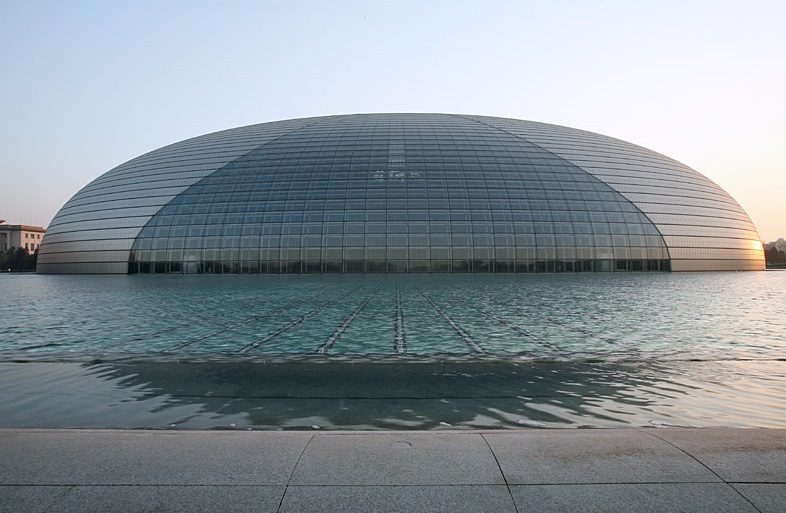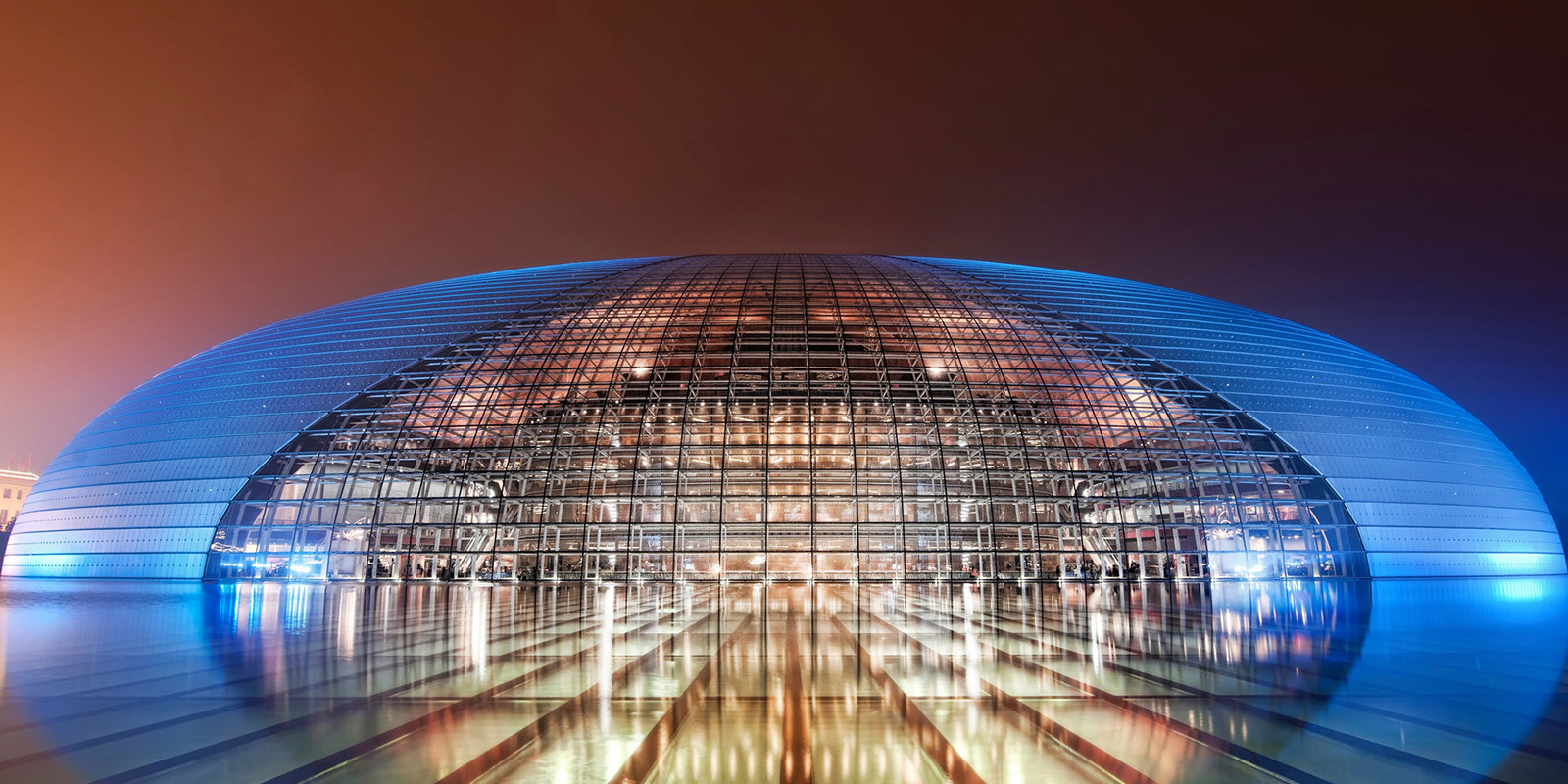National Centre for the Performing Arts, Beijing
Contents |
[edit] Introduction
The National Centre for the Performing Arts (NCPA) is located in the centre of Beijing, China. It is known by its nickname ‘the giant egg’, because of its distinctive flattened-dome shape.
The building is situated like an island in the middle of an artificial lake of 35,500 sq.m. Around the lake a green ring of 39,000 sq.m is intended to isolate the building from the noise of the city.
The NCPA was designed by French architect Paul Andreu, and houses an opera house capable of seating 2,398, a concert hall seating 2,019, a theatre seating 1,035, and a smaller multi-function theatre. Construction work began in 2001, and the inaugural concert was held in December 2007.
Its location provoked some controversy because of its proximity to Tiananmen Square, the Great Hall of the People and the Forbidden City. Andreu argued that, as an important international city, Beijing should include modern as well as ancient traditional Chinese architecture. The inclusion of the lake and the green ring were part of the design solution to complement the ancient architecture and prevent the contrast being too jarring.
[edit] Design and construction
The building is an ellipsoid dome of titanium and glass, designed to resemble an egg floating on water, or a water droplet. Andreu designed the building to be an iconic feature that would be instantly recognisable.
The dome has a maximum span of 213 m (in its east-west direction), a minimum span of 144 m (north-south), and reaches a height of 46 m. The total area of the building is 12,000 sq.m.
It is covered with 18,000 titanium plates, integrated with more than 1,000 sheets of ultra-white glass; a low-iron glass with high light transmission. The titanium shell is divided in two by a curved glass curtain, gradually widening from the top to the bottom where it measures 100 m in width. When illuminated at night this gives the impression of a stage curtain being pulled back, while during the day the glass curtain bathes the interior in light.
Visitors reach the building through the Underwater Corridor, a hallway that stretches beneath the lake from the green ring. The glass ceiling allows light to pass through from the water, producing a shimmering effect.
The large open foyer has a floor made of stone from 10 different regions in China. The interior walls are lined with tens of thousands of panels made of Brazilian rosewood.
[edit] Costs controversy
The building’s initial planned cost was 2.688 bn yuan. However, on completion, this had escalated to more than 3.2 bn yuan. It has been suggested it will be close-to impossible to recuperate the investment. Each individual seat, when averaged out, is worth around 500,000 yuan. On top of this, the huge costs of cleaning the external surface mean that the Chinese government faces subsidising the building for many years. Responding to this though, the Chinese government claimed that the building was never intended to be a for-profit venture.
[edit] Find out more
[edit] Related articles on Designing Buildings Wiki
- Apple Park.
- Beijing Greenland Center.
- Beijing National Stadium.
- Building of the week series.
- CCTV Headquarters.
- China Philharmonic Hall.
- City Hall, London.
- Forbidden City.
- Guggenheim Museum, Bilbao.
- Niteroi Contemporary Art Museum.
- Phoenix International Media Center, Beijing.
- Rose Museum.
- Royal Albert Hall.
- Sage Gateshead.
- Sydney Opera House.
- Types of dome.
- Unusual building design of the week.
- Xili Sports and Cultural Centre.
[edit] External resources
- Arcspace - National Centre for the Performing Arts
Featured articles and news
Professional practical experience for Architects in training
The long process to transform the nature of education and professional practical experience in the Architecture profession following recent reports.
A people-first approach to retrofit
Moving away from the destructive paradigm of fabric-first.
International Electrician Day, 10 June 2025
Celebrating the role of electrical engineers from André-Marie Amperè, today and for the future.
New guide for clients launched at Houses of Parliament
'There has never been a more important time for clients to step up and ...ask the right questions'
The impact of recycled slate tiles
Innovation across the decades.
EPC changes for existing buildings
Changes and their context as the new RdSAP methodology comes into use from 15 June.
Skills England publishes Sector skills needs assessments
Priority areas relating to the built environment highlighted and described in brief.
BSRIA HVAC Market Watch - May 2025 Edition
Heat Pump Market Outlook: Policy, Performance & Refrigerant Trends for 2025–2028.
Committing to EDI in construction with CIOB
Built Environment professional bodies deepen commitment to EDI with two new signatories: CIAT and CICES.
Government Grenfell progress report at a glance
Line by line recomendation overview, with links to more details.
An engaging and lively review of his professional life.
Sustainable heating for listed buildings
A problem that needs to be approached intelligently.
50th Golden anniversary ECA Edmundson apprentice award
Deadline for entries has been extended to Friday 27 June, so don't miss out!
CIAT at the London Festival of Architecture
Designing for Everyone: Breaking Barriers in Inclusive Architecture.
Mixed reactions to apprenticeship and skills reform 2025
A 'welcome shift' for some and a 'backwards step' for others.























